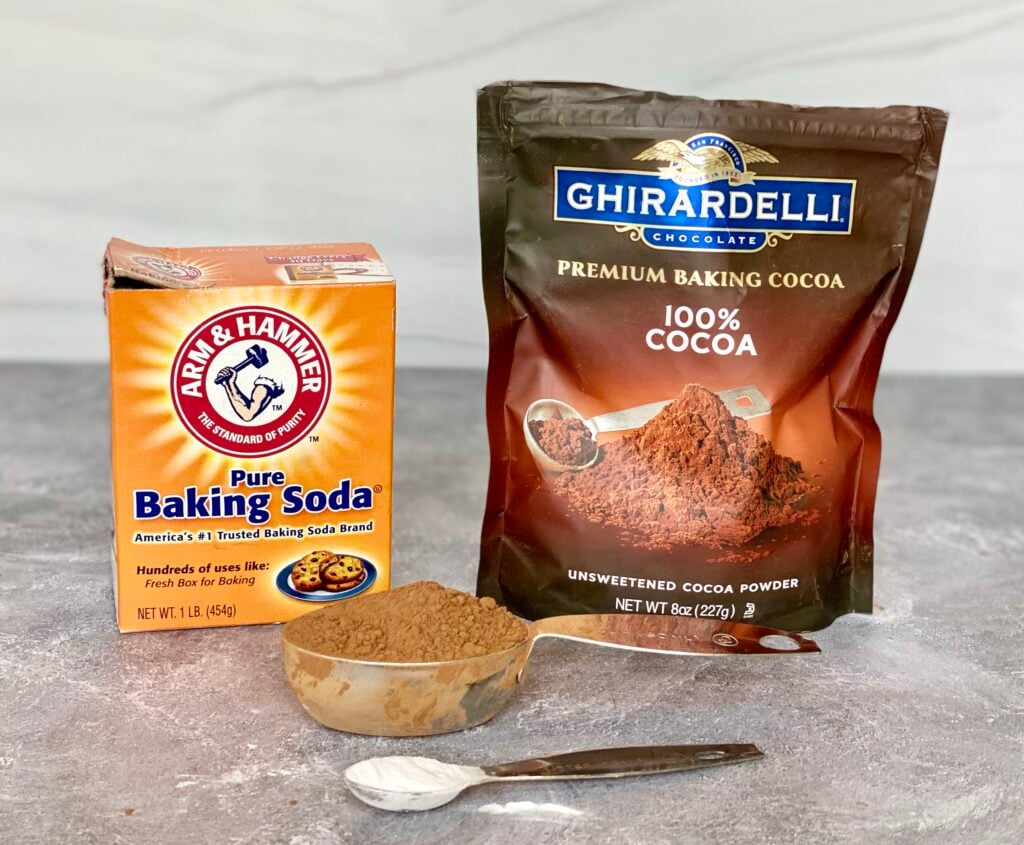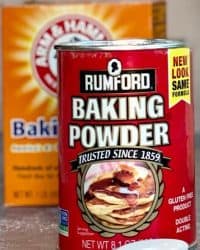If you don’t really know the difference between these two ingredients, you’re in good company. Most people have absolutely no idea what the difference is between baking powder and baking soda.
Full disclosure: I was among your ranks until just a few years ago. But now I have the ability to help, so help I will! Let’s do this.
1. Baking Soda and Baking Powder are Chemical Leaveners.
To be completely technical (sorry…baking nerd here), leavening is the ingredient that causes a chemical reaction in your dough or batter, forcing it to expand, or rise.
There are natural leaveners (for example, yeast and whipped egg whites) and chemical leaveners (mainly baking soda and baking powder, and occasionally cream of tartar).
For this post, we’re focusing on the two most common chemical leaveners found in a home kitchen: baking soda and baking powder.

Chemical leaveners work by creating a reaction between a base (or alkaline substance) and an acid (or acidic ingredient). The result is carbon dioxide bubbles that force your batter to expand. It’s the same chemical reaction that we learned about in middle school science with that papier-mâché volcano and the red food coloring. Remember that science project? Same principle.
It sounds like an oversimplification but it’s really not! That’s truly all there is to baking powder and baking soda. They’re not so intimidating when you think about them like that, are they? Let’s go on ahead and break it down.
2. Baking Soda Needs Acid.
In chemistry terms, baking soda (or bicarbonate of soda) is a base. That means that in order to create bubbles, it needs something acidic. Think of baking soda as “needing a little oomph”, like I did here with white vinegar:
Common examples of acids used in baking soda recipes are buttermilk, lemon juice, vinegar, brown sugar, yogurt, apple sauce, cream of tartar, and even yummy molasses.
For people working with cocoa powder, natural cocoa powder is naturally acidic. So baking soda would pair with natural cocoa powder for chocolate cake recipes.

Baking soda needs to be completely neutralized by the acid in your recipe, or you can end up with a soapy or metallic aftertaste. Ever notice this taste in your cupcakes? Too much undissolved baking soda is the likely culprit.
If a recipe uses baking soda, it’s probably using at least one of the acidic ingredients above. That means that you likely don’t have to worry about soap or metal in your mouth. BUT it’s important to measure baking soda properly (no heaping teaspoons needed!) in order to ensure that you’ve got the right proportion to make the proper chemical reaction and to ensure that all of that baking soda dissolves.
A tiny bit of this stuff goes a very long way. For every cup of flour in your recipe, you usually only need a very level quarter teaspoon.
3. Baking Powder Has Acid.
Baking powder contains baking soda.

I think of baking powder as baking soda 2.0. Because baking powder is actually baking soda plus the acid that it needs in order to react and create those glorious bubbles. There’s also a third ingredient (usually cornstarch) that acts as a mediator, to keep the acid and base from combusting in the can and rendering the whole thing useless before you even get started.
Long story short? You don’t have to do mental gymnastics in order to figure out how much acid you need to neutralize the baking soda that’s contained in baking powder because it’s already done for you. For this reason, baking powder is used more widely in home baking, since there’s much less guesswork involved.
It’s still potent though, and using more than necessary can lead to dramatically bad results. So…still no heaping teaspoons please and thank you.
When developing recipes, the general rule of thumb that I use is one level teaspoon of baking powder for every cup of flour.
For chocolate cake bakers, baking powder is what you use when you’re using Dutch-process cocoa powder. Dutched cocoa powder is cocoa powder that’s been stripped of its acidic properties, and thus it won’t react with your leavening.

3. Can They Be Used Interchangeably?
To quote the inimitable Dr. Ian Malcolm (Jurassic Park, circa 1993): “Your scientists were so preoccupied with whether or not they could, they didn’t stop to think if they should.”
Same energy here.

It is true that baking soda and baking powder share a primary ingredient, and thus, in theory, you should be able to use them interchangeably with some minor tweaks.
As we learned from Jurassic Park, theory and practice aren’t always aligned.
The switcheroo math for baking powder and baking soda is quite tricky. Because baking soda is, pound-for-pound, much more potent than baking powder, and also because of the fact that baking powder already has the acid that baking soda needs, it’s not possible to do a simple 1:1 swap.
Swapping baking soda for baking powder means that you also have to add additional acid to your recipe in order to make the leavening work properly. Swapping baking powder for baking soda means that you might have to reduce the amount of baking powder and any other acidic ingredient in your recipe in order to avoid an over-leavened cake.
There’s…a lot of chemistry involved, and I don’t typically recommend ingredient swaps that will force you to significantly adjust two or more ingredients in your recipe. You can pretty much expect an unpleasant taste and texture issue when you do that.
While I encourage trial and error for more advanced bakers in the recipe development process, for beginners I think it’s important to stick to the recipe as written. This will help build confidence in the kitchen and will also help build your baking science competence! Remember, today’s advanced bakers were yesterday’s rank beginners!
With experience, you’ll get to the point where your experimentation will have a high probability of success, because you’ll understand the science behind these powerful ingredients. But best to learn the science first. To quote Smokey (Friday), “you gotta crawl before you walk.”
TL;DR version: Can they be used interchangeably? Kinda. Should they? Probably not. (I don’t recommend.)
4. Why Do Some Recipes Use Both?
Sometimes, you’ll find recipes that use baking powder and baking soda. I’ve found that this happens mainly because the recipe writer intended to leave a bit of the “tangy” flavor that comes from the acidic ingredient. For example, my favorite buttermilk pancake recipe uses both baking powder and baking soda.

Used in just the right proportions, the acid in the baking powder and the acid in the buttermilk will dissolve all of that baking soda, whilst leaving just enough of a yummy, tangy flavor from the buttermilk to really make your recipe special. So, for many recipes that use both, it’s usually more about adding that je ne sais quois that will take the taste of the recipe over the top.
There are some times that both baking powder and baking soda are needed to make a cake rise to the level that the recipe developer intended. Additionally, sometimes using both will help your confections achieve an even more perfect golden brown.
5. How Do I Know if I’m Working with Good Baking Soda or Baking Powder?
Test it before you start! To test baking soda, add 2 tablespoons of white vinegar to 1/4 teaspoon of baking soda (like I did in the video above). If it bubbles vigorously (like it did in the video above), then it’s good to go!
Some people replace baking soda every 30 days. I bake almost every day and even I don’t go through a box of baking soda a month. Because potent. If you do a quick test, you can know for certain whether you’re working with viable baking soda. It’s not necessary to waste good baking soda every 30 days.
To test baking powder, just add a quarter teaspoon of baking powder to 63 mL (1/4 cup) of very hot water. The baking powder should fizz immediately.
Whether you’re testing baking soda or baking powder, you’re looking for a vigorous reaction. If you don’t get that vigorous reaction, I recommend replacing it before you start. I would hate to see you get frustrated because you spent two hours making something that doesn’t ultimately rise.
Baking soda finds a second life under my kitchen sink, though. It’s a great additive to dish detergent for stuck-on food.
I hope you enjoyed this primer on baking soda and baking soda. Don’t forget to subscribe in order to get Begin with Butter baking tips delivered right to your inbox! Until next time!



Great tips!
Thank you so much! I’m so glad you found them helpful.
Excellent tutorial. As a former chemist I appreciate your explanations & how to use them in recipe development. Thank you.
Thank you so much for this! My scientific heart just skipped a beat!